The Impact of Remuneration on Microfinance Worker Performance
VerifiedAdded on 2023/03/31
|10
|1649
|480
Report
AI Summary
This report delves into the critical role of remuneration in enhancing the performance of microfinance workers. It begins by defining remuneration and its impact on employee motivation and organizational productivity. The study addresses the challenges in microfinance and explores the specific services offered by these institutions, including loans, savings, and insurance. The report sets objectives to improve microfinance performance and define the link between compensation policies and employee outcomes. A comprehensive literature review covers the concept of worker remuneration, compensation policies, and the application of technology. It also explores the human capital theory and the importance of training. The study then examines organizational development models, specifically the Kotter change model, and its application to microfinance. The report concludes with recommendations for implementing change, including training programs for executives on the benefits of fair compensation, and emphasizes the need for measurable results to streamline work and improve various aspects of the organization, such as patient safety, cost, and employee satisfaction. The report provides a summary and conclusion, along with a list of relevant references.
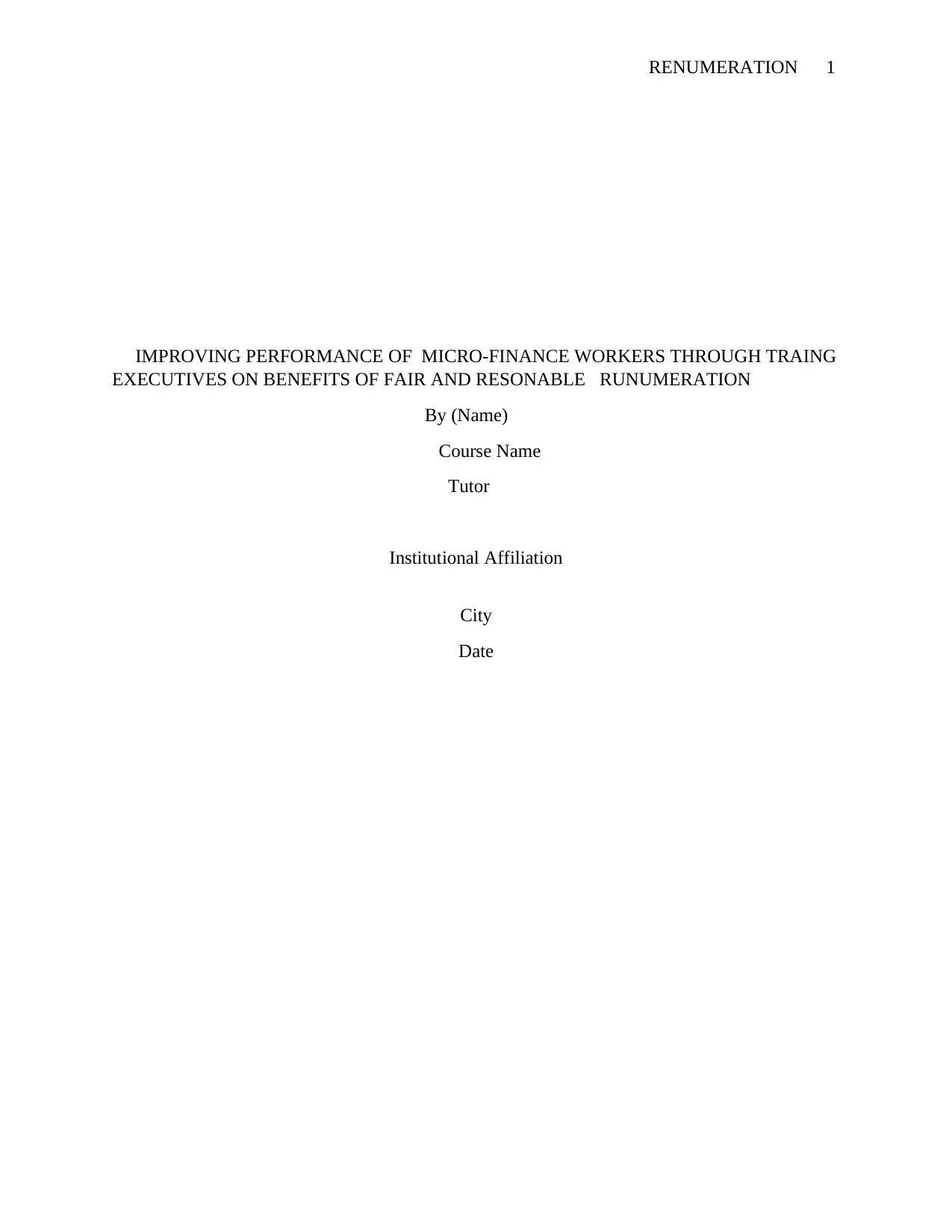
RENUMERATION 1
IMPROVING PERFORMANCE OF MICRO-FINANCE WORKERS THROUGH TRAING
EXECUTIVES ON BENEFITS OF FAIR AND RESONABLE RUNUMERATION
By (Name)
Course Name
Tutor
Institutional Affiliation
City
Date
IMPROVING PERFORMANCE OF MICRO-FINANCE WORKERS THROUGH TRAING
EXECUTIVES ON BENEFITS OF FAIR AND RESONABLE RUNUMERATION
By (Name)
Course Name
Tutor
Institutional Affiliation
City
Date
Paraphrase This Document
Need a fresh take? Get an instant paraphrase of this document with our AI Paraphraser

REMUNERATION 2
INTRODUCTION
The human resource departments in every organization has undergone through
incredible transformation from the global and local environments. The idea of the worker
remuneration has grown over time. Remuneration is considered as one of the common factors
which have a big impact on the employee performance. This has made the human resource
experts to believe that staffs consider salary to be an important factor in their place of work.
When staffs are motivated through good remunerations, their work performance greatly
increases.
Statement of the problem.
Organizational performance includes the actual productivity or outcomes of an
association as compared to its projected productions. However the performance of work is
always affected by its workers, who in turn may require motivation in order to perform. There
has been many challenges concerning remuneration which negatively affect the overall
organization performance.
Microfinance
INTRODUCTION
The human resource departments in every organization has undergone through
incredible transformation from the global and local environments. The idea of the worker
remuneration has grown over time. Remuneration is considered as one of the common factors
which have a big impact on the employee performance. This has made the human resource
experts to believe that staffs consider salary to be an important factor in their place of work.
When staffs are motivated through good remunerations, their work performance greatly
increases.
Statement of the problem.
Organizational performance includes the actual productivity or outcomes of an
association as compared to its projected productions. However the performance of work is
always affected by its workers, who in turn may require motivation in order to perform. There
has been many challenges concerning remuneration which negatively affect the overall
organization performance.
Microfinance
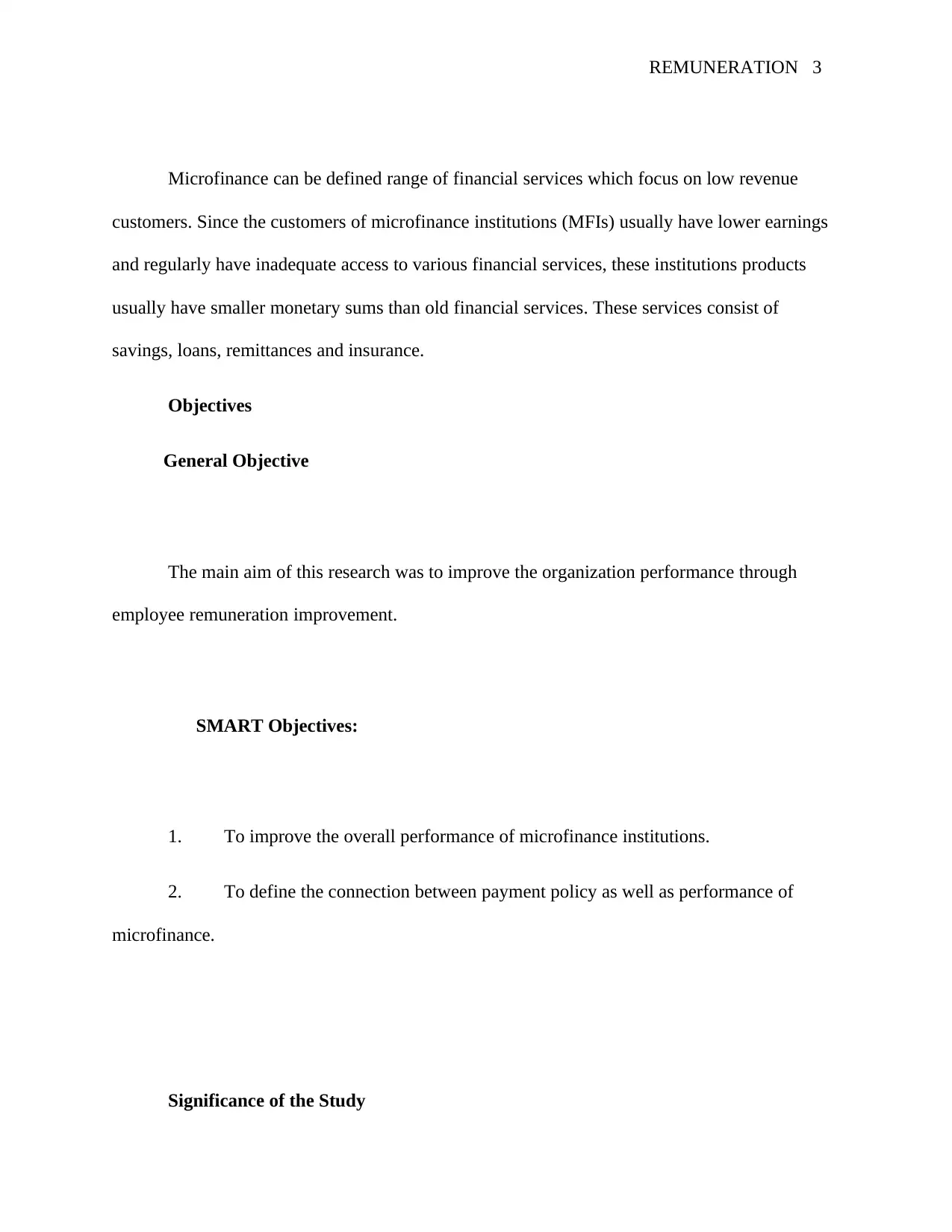
REMUNERATION 3
Microfinance can be defined range of financial services which focus on low revenue
customers. Since the customers of microfinance institutions (MFIs) usually have lower earnings
and regularly have inadequate access to various financial services, these institutions products
usually have smaller monetary sums than old financial services. These services consist of
savings, loans, remittances and insurance.
Objectives
General Objective
The main aim of this research was to improve the organization performance through
employee remuneration improvement.
SMART Objectives:
1. To improve the overall performance of microfinance institutions.
2. To define the connection between payment policy as well as performance of
microfinance.
Significance of the Study
Microfinance can be defined range of financial services which focus on low revenue
customers. Since the customers of microfinance institutions (MFIs) usually have lower earnings
and regularly have inadequate access to various financial services, these institutions products
usually have smaller monetary sums than old financial services. These services consist of
savings, loans, remittances and insurance.
Objectives
General Objective
The main aim of this research was to improve the organization performance through
employee remuneration improvement.
SMART Objectives:
1. To improve the overall performance of microfinance institutions.
2. To define the connection between payment policy as well as performance of
microfinance.
Significance of the Study
⊘ This is a preview!⊘
Do you want full access?
Subscribe today to unlock all pages.

Trusted by 1+ million students worldwide
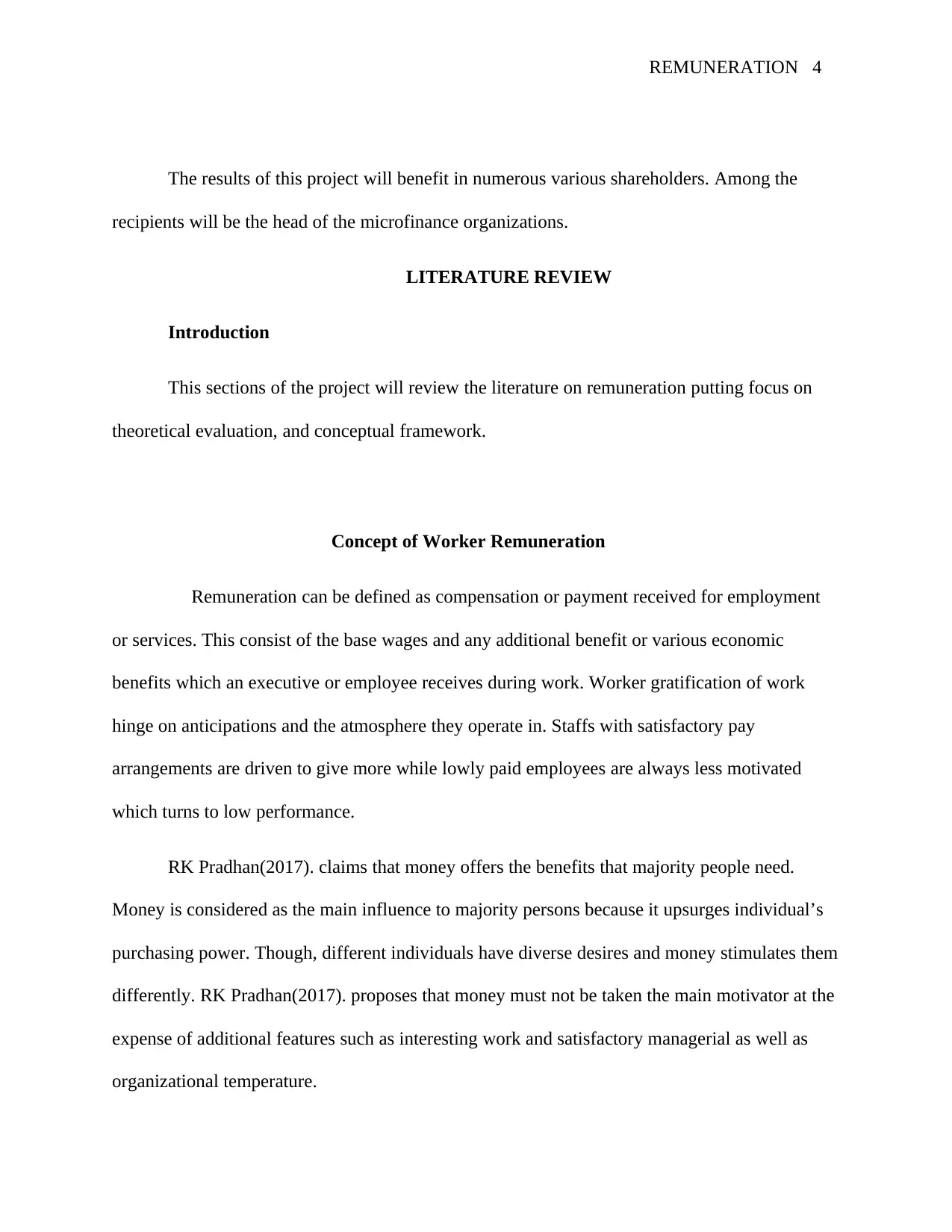
REMUNERATION 4
The results of this project will benefit in numerous various shareholders. Among the
recipients will be the head of the microfinance organizations.
LITERATURE REVIEW
Introduction
This sections of the project will review the literature on remuneration putting focus on
theoretical evaluation, and conceptual framework.
Concept of Worker Remuneration
Remuneration can be defined as compensation or payment received for employment
or services. This consist of the base wages and any additional benefit or various economic
benefits which an executive or employee receives during work. Worker gratification of work
hinge on anticipations and the atmosphere they operate in. Staffs with satisfactory pay
arrangements are driven to give more while lowly paid employees are always less motivated
which turns to low performance.
RK Pradhan(2017). claims that money offers the benefits that majority people need.
Money is considered as the main influence to majority persons because it upsurges individual’s
purchasing power. Though, different individuals have diverse desires and money stimulates them
differently. RK Pradhan(2017). proposes that money must not be taken the main motivator at the
expense of additional features such as interesting work and satisfactory managerial as well as
organizational temperature.
The results of this project will benefit in numerous various shareholders. Among the
recipients will be the head of the microfinance organizations.
LITERATURE REVIEW
Introduction
This sections of the project will review the literature on remuneration putting focus on
theoretical evaluation, and conceptual framework.
Concept of Worker Remuneration
Remuneration can be defined as compensation or payment received for employment
or services. This consist of the base wages and any additional benefit or various economic
benefits which an executive or employee receives during work. Worker gratification of work
hinge on anticipations and the atmosphere they operate in. Staffs with satisfactory pay
arrangements are driven to give more while lowly paid employees are always less motivated
which turns to low performance.
RK Pradhan(2017). claims that money offers the benefits that majority people need.
Money is considered as the main influence to majority persons because it upsurges individual’s
purchasing power. Though, different individuals have diverse desires and money stimulates them
differently. RK Pradhan(2017). proposes that money must not be taken the main motivator at the
expense of additional features such as interesting work and satisfactory managerial as well as
organizational temperature.
Paraphrase This Document
Need a fresh take? Get an instant paraphrase of this document with our AI Paraphraser
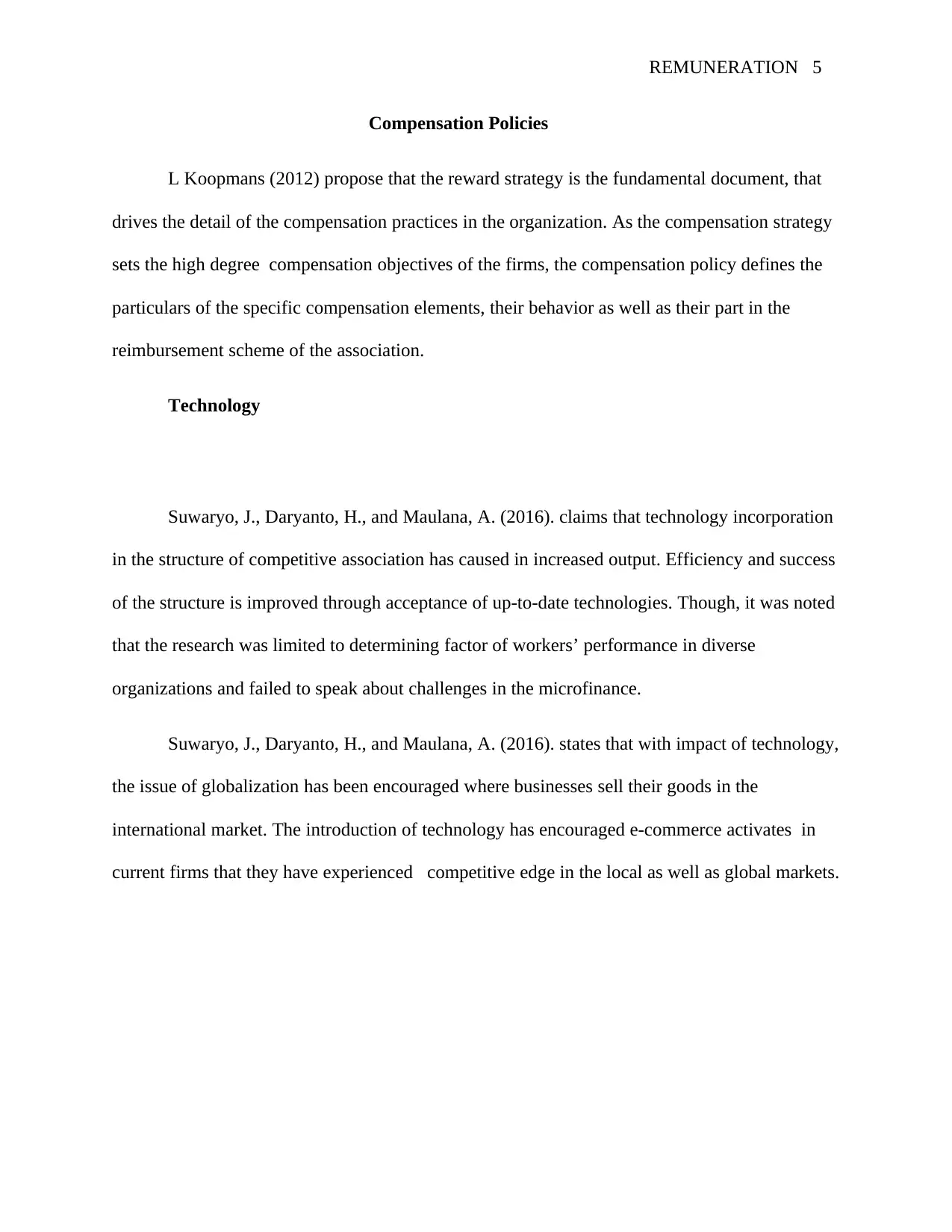
REMUNERATION 5
Compensation Policies
L Koopmans (2012) propose that the reward strategy is the fundamental document, that
drives the detail of the compensation practices in the organization. As the compensation strategy
sets the high degree compensation objectives of the firms, the compensation policy defines the
particulars of the specific compensation elements, their behavior as well as their part in the
reimbursement scheme of the association.
Technology
Suwaryo, J., Daryanto, H., and Maulana, A. (2016). claims that technology incorporation
in the structure of competitive association has caused in increased output. Efficiency and success
of the structure is improved through acceptance of up-to-date technologies. Though, it was noted
that the research was limited to determining factor of workers’ performance in diverse
organizations and failed to speak about challenges in the microfinance.
Suwaryo, J., Daryanto, H., and Maulana, A. (2016). states that with impact of technology,
the issue of globalization has been encouraged where businesses sell their goods in the
international market. The introduction of technology has encouraged e-commerce activates in
current firms that they have experienced competitive edge in the local as well as global markets.
Compensation Policies
L Koopmans (2012) propose that the reward strategy is the fundamental document, that
drives the detail of the compensation practices in the organization. As the compensation strategy
sets the high degree compensation objectives of the firms, the compensation policy defines the
particulars of the specific compensation elements, their behavior as well as their part in the
reimbursement scheme of the association.
Technology
Suwaryo, J., Daryanto, H., and Maulana, A. (2016). claims that technology incorporation
in the structure of competitive association has caused in increased output. Efficiency and success
of the structure is improved through acceptance of up-to-date technologies. Though, it was noted
that the research was limited to determining factor of workers’ performance in diverse
organizations and failed to speak about challenges in the microfinance.
Suwaryo, J., Daryanto, H., and Maulana, A. (2016). states that with impact of technology,
the issue of globalization has been encouraged where businesses sell their goods in the
international market. The introduction of technology has encouraged e-commerce activates in
current firms that they have experienced competitive edge in the local as well as global markets.
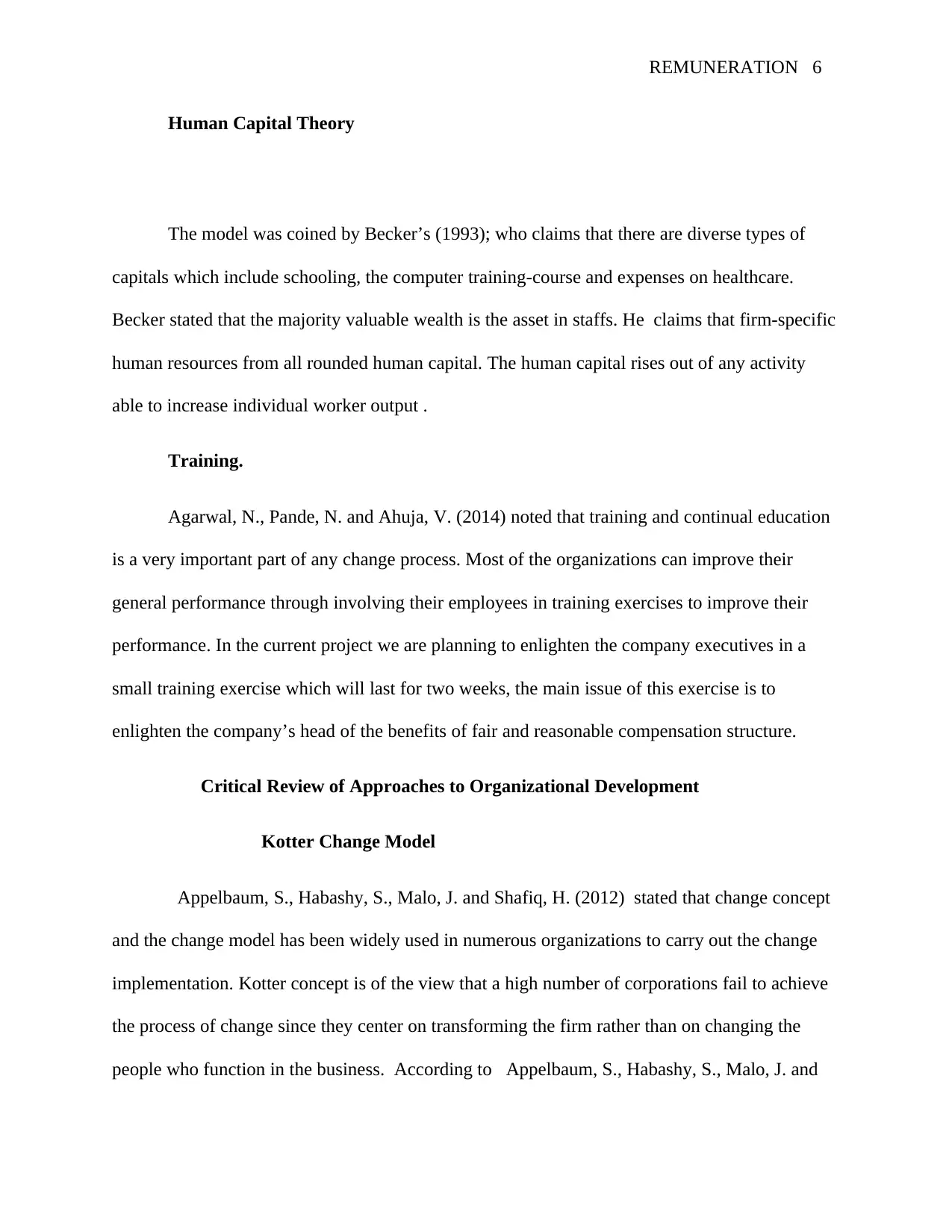
REMUNERATION 6
Human Capital Theory
The model was coined by Becker’s (1993); who claims that there are diverse types of
capitals which include schooling, the computer training-course and expenses on healthcare.
Becker stated that the majority valuable wealth is the asset in staffs. He claims that firm-specific
human resources from all rounded human capital. The human capital rises out of any activity
able to increase individual worker output .
Training.
Agarwal, N., Pande, N. and Ahuja, V. (2014) noted that training and continual education
is a very important part of any change process. Most of the organizations can improve their
general performance through involving their employees in training exercises to improve their
performance. In the current project we are planning to enlighten the company executives in a
small training exercise which will last for two weeks, the main issue of this exercise is to
enlighten the company’s head of the benefits of fair and reasonable compensation structure.
Critical Review of Approaches to Organizational Development
Kotter Change Model
Appelbaum, S., Habashy, S., Malo, J. and Shafiq, H. (2012) stated that change concept
and the change model has been widely used in numerous organizations to carry out the change
implementation. Kotter concept is of the view that a high number of corporations fail to achieve
the process of change since they center on transforming the firm rather than on changing the
people who function in the business. According to Appelbaum, S., Habashy, S., Malo, J. and
Human Capital Theory
The model was coined by Becker’s (1993); who claims that there are diverse types of
capitals which include schooling, the computer training-course and expenses on healthcare.
Becker stated that the majority valuable wealth is the asset in staffs. He claims that firm-specific
human resources from all rounded human capital. The human capital rises out of any activity
able to increase individual worker output .
Training.
Agarwal, N., Pande, N. and Ahuja, V. (2014) noted that training and continual education
is a very important part of any change process. Most of the organizations can improve their
general performance through involving their employees in training exercises to improve their
performance. In the current project we are planning to enlighten the company executives in a
small training exercise which will last for two weeks, the main issue of this exercise is to
enlighten the company’s head of the benefits of fair and reasonable compensation structure.
Critical Review of Approaches to Organizational Development
Kotter Change Model
Appelbaum, S., Habashy, S., Malo, J. and Shafiq, H. (2012) stated that change concept
and the change model has been widely used in numerous organizations to carry out the change
implementation. Kotter concept is of the view that a high number of corporations fail to achieve
the process of change since they center on transforming the firm rather than on changing the
people who function in the business. According to Appelbaum, S., Habashy, S., Malo, J. and
⊘ This is a preview!⊘
Do you want full access?
Subscribe today to unlock all pages.

Trusted by 1+ million students worldwide
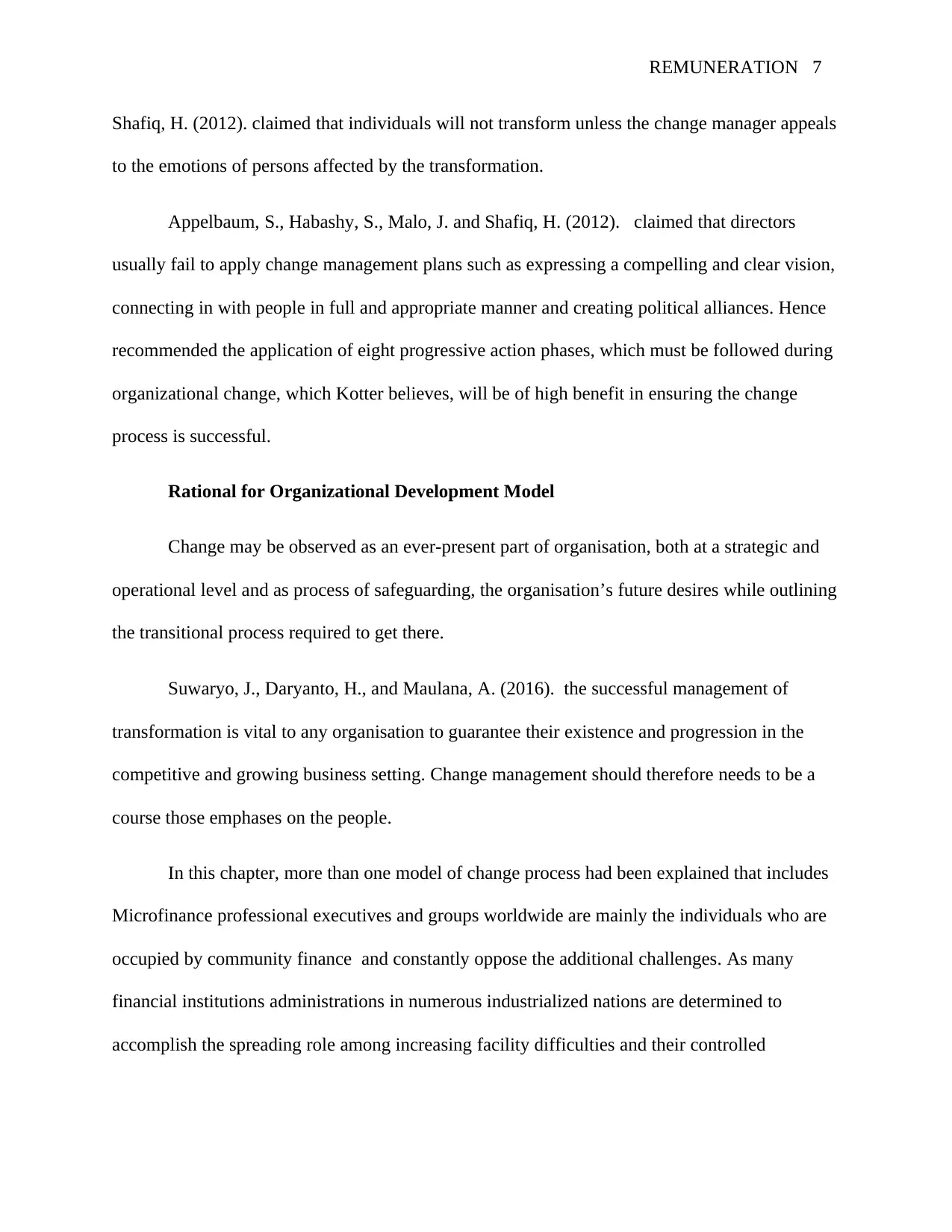
REMUNERATION 7
Shafiq, H. (2012). claimed that individuals will not transform unless the change manager appeals
to the emotions of persons affected by the transformation.
Appelbaum, S., Habashy, S., Malo, J. and Shafiq, H. (2012). claimed that directors
usually fail to apply change management plans such as expressing a compelling and clear vision,
connecting in with people in full and appropriate manner and creating political alliances. Hence
recommended the application of eight progressive action phases, which must be followed during
organizational change, which Kotter believes, will be of high benefit in ensuring the change
process is successful.
Rational for Organizational Development Model
Change may be observed as an ever-present part of organisation, both at a strategic and
operational level and as process of safeguarding, the organisation’s future desires while outlining
the transitional process required to get there.
Suwaryo, J., Daryanto, H., and Maulana, A. (2016). the successful management of
transformation is vital to any organisation to guarantee their existence and progression in the
competitive and growing business setting. Change management should therefore needs to be a
course those emphases on the people.
In this chapter, more than one model of change process had been explained that includes
Microfinance professional executives and groups worldwide are mainly the individuals who are
occupied by community finance and constantly oppose the additional challenges. As many
financial institutions administrations in numerous industrialized nations are determined to
accomplish the spreading role among increasing facility difficulties and their controlled
Shafiq, H. (2012). claimed that individuals will not transform unless the change manager appeals
to the emotions of persons affected by the transformation.
Appelbaum, S., Habashy, S., Malo, J. and Shafiq, H. (2012). claimed that directors
usually fail to apply change management plans such as expressing a compelling and clear vision,
connecting in with people in full and appropriate manner and creating political alliances. Hence
recommended the application of eight progressive action phases, which must be followed during
organizational change, which Kotter believes, will be of high benefit in ensuring the change
process is successful.
Rational for Organizational Development Model
Change may be observed as an ever-present part of organisation, both at a strategic and
operational level and as process of safeguarding, the organisation’s future desires while outlining
the transitional process required to get there.
Suwaryo, J., Daryanto, H., and Maulana, A. (2016). the successful management of
transformation is vital to any organisation to guarantee their existence and progression in the
competitive and growing business setting. Change management should therefore needs to be a
course those emphases on the people.
In this chapter, more than one model of change process had been explained that includes
Microfinance professional executives and groups worldwide are mainly the individuals who are
occupied by community finance and constantly oppose the additional challenges. As many
financial institutions administrations in numerous industrialized nations are determined to
accomplish the spreading role among increasing facility difficulties and their controlled
Paraphrase This Document
Need a fresh take? Get an instant paraphrase of this document with our AI Paraphraser
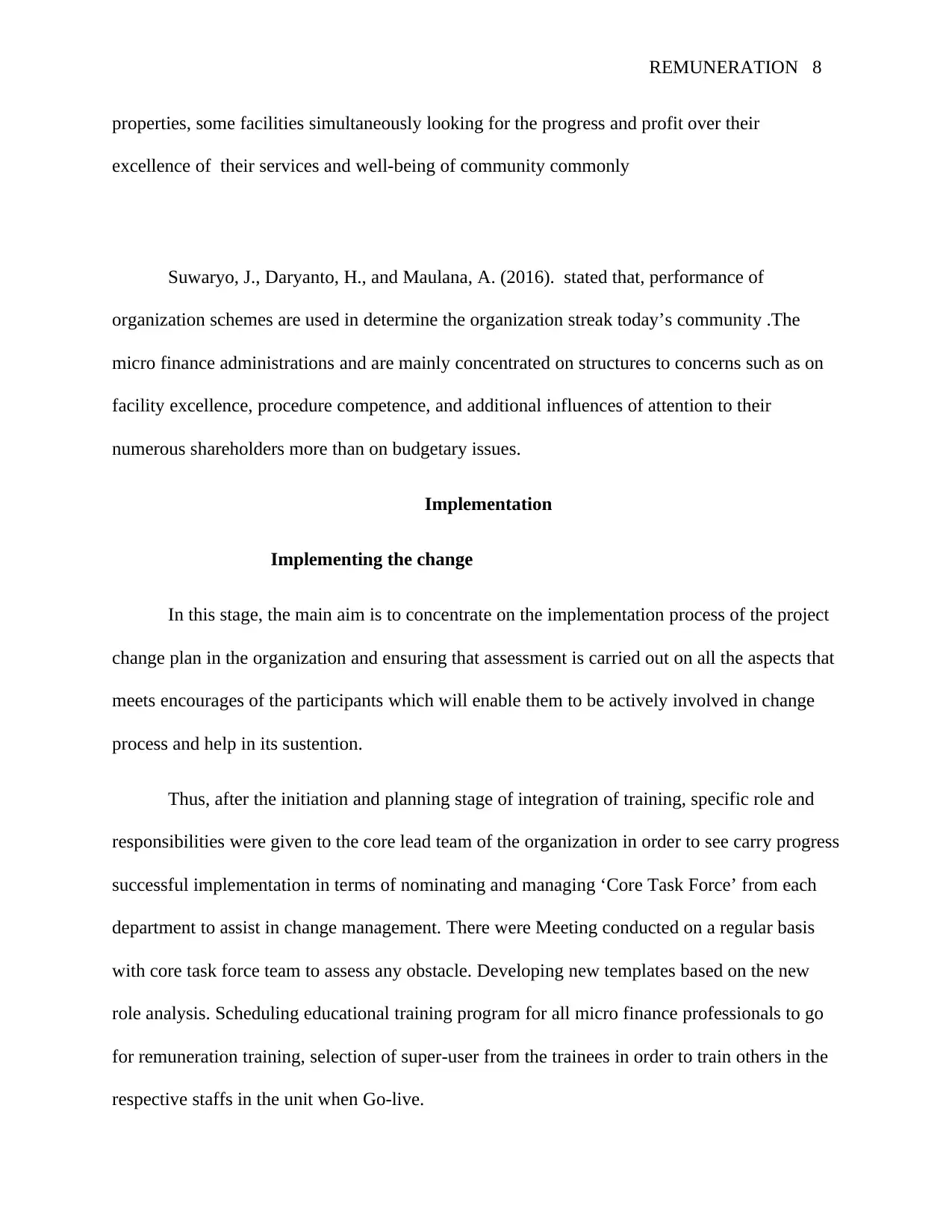
REMUNERATION 8
properties, some facilities simultaneously looking for the progress and profit over their
excellence of their services and well-being of community commonly
Suwaryo, J., Daryanto, H., and Maulana, A. (2016). stated that, performance of
organization schemes are used in determine the organization streak today’s community .The
micro finance administrations and are mainly concentrated on structures to concerns such as on
facility excellence, procedure competence, and additional influences of attention to their
numerous shareholders more than on budgetary issues.
Implementation
Implementing the change
In this stage, the main aim is to concentrate on the implementation process of the project
change plan in the organization and ensuring that assessment is carried out on all the aspects that
meets encourages of the participants which will enable them to be actively involved in change
process and help in its sustention.
Thus, after the initiation and planning stage of integration of training, specific role and
responsibilities were given to the core lead team of the organization in order to see carry progress
successful implementation in terms of nominating and managing ‘Core Task Force’ from each
department to assist in change management. There were Meeting conducted on a regular basis
with core task force team to assess any obstacle. Developing new templates based on the new
role analysis. Scheduling educational training program for all micro finance professionals to go
for remuneration training, selection of super-user from the trainees in order to train others in the
respective staffs in the unit when Go-live.
properties, some facilities simultaneously looking for the progress and profit over their
excellence of their services and well-being of community commonly
Suwaryo, J., Daryanto, H., and Maulana, A. (2016). stated that, performance of
organization schemes are used in determine the organization streak today’s community .The
micro finance administrations and are mainly concentrated on structures to concerns such as on
facility excellence, procedure competence, and additional influences of attention to their
numerous shareholders more than on budgetary issues.
Implementation
Implementing the change
In this stage, the main aim is to concentrate on the implementation process of the project
change plan in the organization and ensuring that assessment is carried out on all the aspects that
meets encourages of the participants which will enable them to be actively involved in change
process and help in its sustention.
Thus, after the initiation and planning stage of integration of training, specific role and
responsibilities were given to the core lead team of the organization in order to see carry progress
successful implementation in terms of nominating and managing ‘Core Task Force’ from each
department to assist in change management. There were Meeting conducted on a regular basis
with core task force team to assess any obstacle. Developing new templates based on the new
role analysis. Scheduling educational training program for all micro finance professionals to go
for remuneration training, selection of super-user from the trainees in order to train others in the
respective staffs in the unit when Go-live.
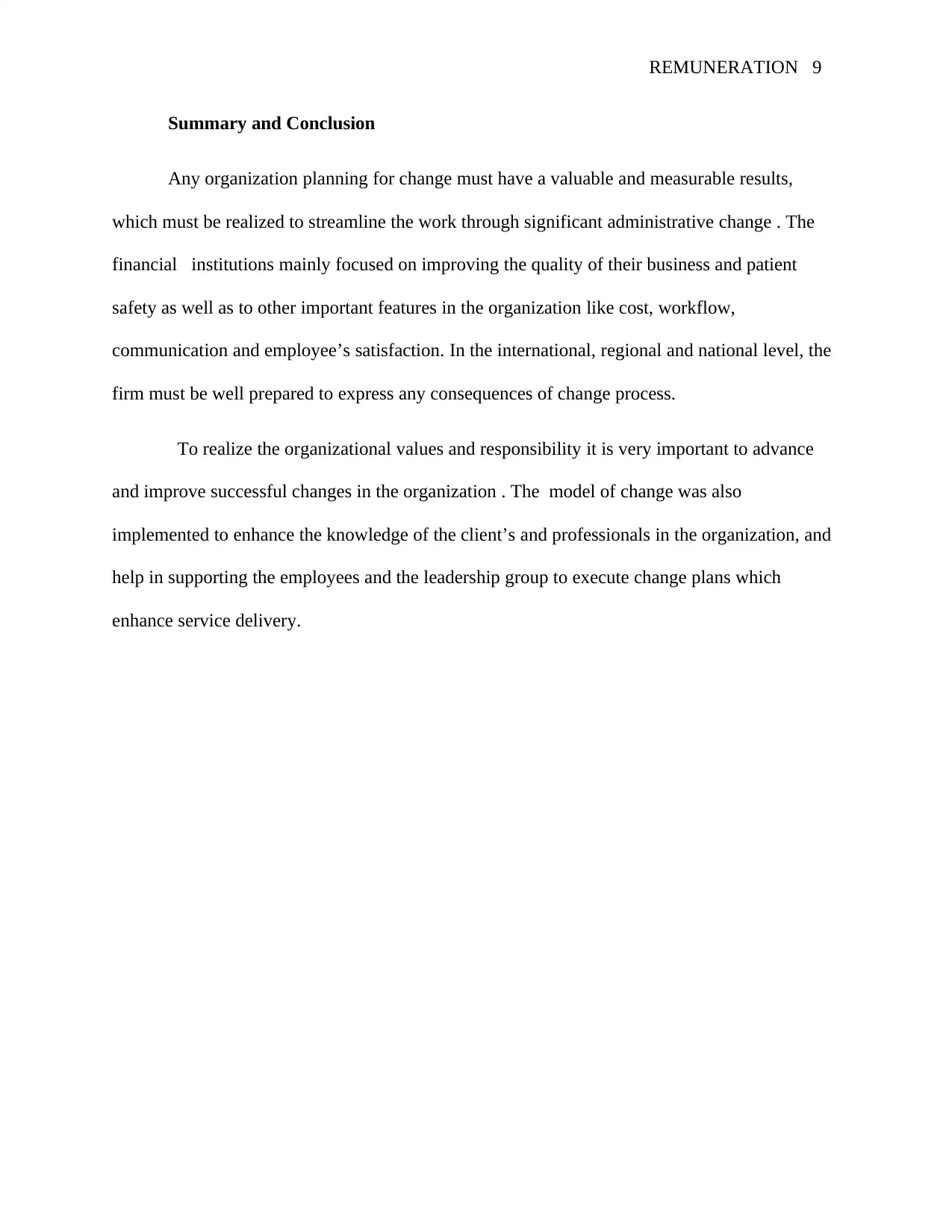
REMUNERATION 9
Summary and Conclusion
Any organization planning for change must have a valuable and measurable results,
which must be realized to streamline the work through significant administrative change . The
financial institutions mainly focused on improving the quality of their business and patient
safety as well as to other important features in the organization like cost, workflow,
communication and employee’s satisfaction. In the international, regional and national level, the
firm must be well prepared to express any consequences of change process.
To realize the organizational values and responsibility it is very important to advance
and improve successful changes in the organization . The model of change was also
implemented to enhance the knowledge of the client’s and professionals in the organization, and
help in supporting the employees and the leadership group to execute change plans which
enhance service delivery.
Summary and Conclusion
Any organization planning for change must have a valuable and measurable results,
which must be realized to streamline the work through significant administrative change . The
financial institutions mainly focused on improving the quality of their business and patient
safety as well as to other important features in the organization like cost, workflow,
communication and employee’s satisfaction. In the international, regional and national level, the
firm must be well prepared to express any consequences of change process.
To realize the organizational values and responsibility it is very important to advance
and improve successful changes in the organization . The model of change was also
implemented to enhance the knowledge of the client’s and professionals in the organization, and
help in supporting the employees and the leadership group to execute change plans which
enhance service delivery.
⊘ This is a preview!⊘
Do you want full access?
Subscribe today to unlock all pages.

Trusted by 1+ million students worldwide
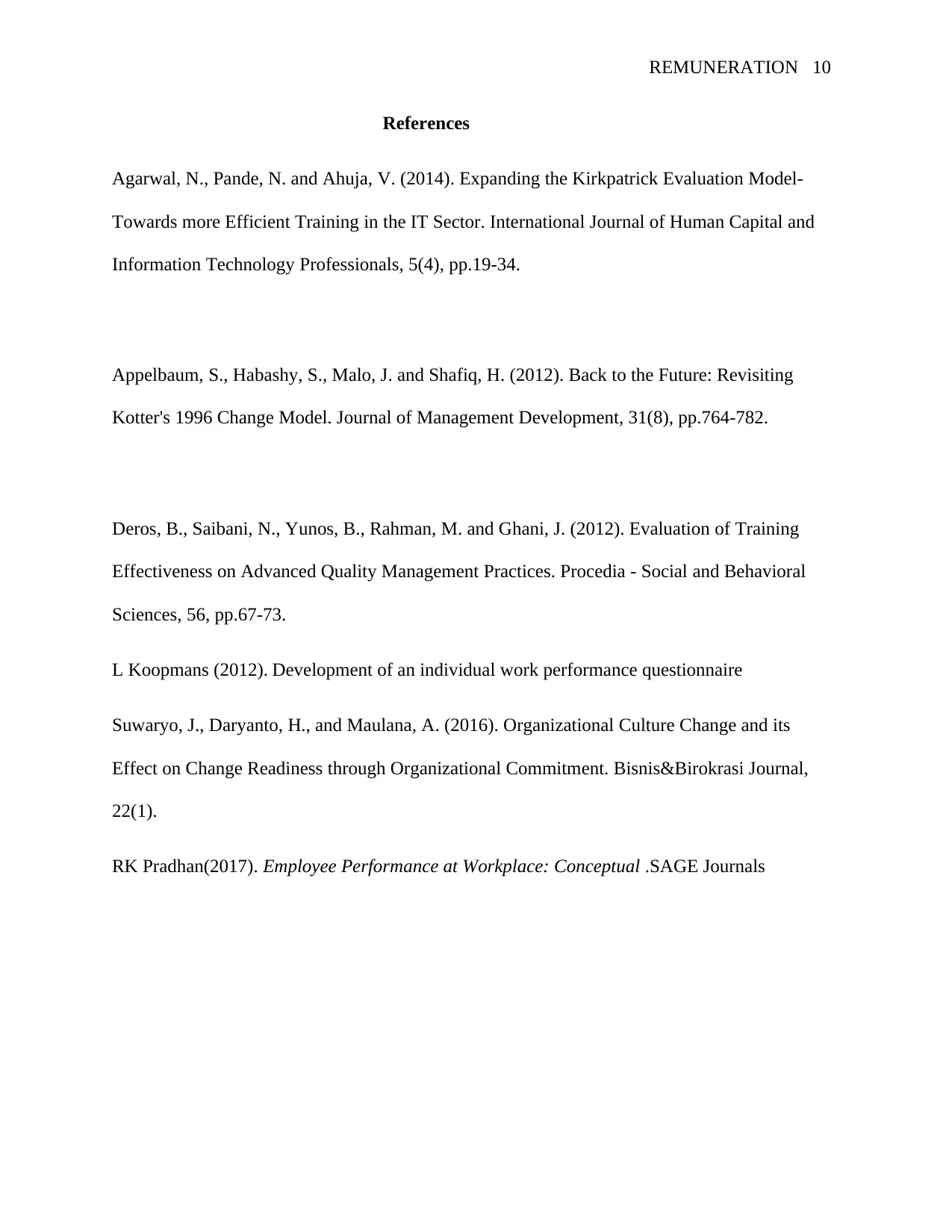
REMUNERATION 10
References
Agarwal, N., Pande, N. and Ahuja, V. (2014). Expanding the Kirkpatrick Evaluation Model-
Towards more Efficient Training in the IT Sector. International Journal of Human Capital and
Information Technology Professionals, 5(4), pp.19-34.
Appelbaum, S., Habashy, S., Malo, J. and Shafiq, H. (2012). Back to the Future: Revisiting
Kotter's 1996 Change Model. Journal of Management Development, 31(8), pp.764-782.
Deros, B., Saibani, N., Yunos, B., Rahman, M. and Ghani, J. (2012). Evaluation of Training
Effectiveness on Advanced Quality Management Practices. Procedia - Social and Behavioral
Sciences, 56, pp.67-73.
L Koopmans (2012). Development of an individual work performance questionnaire
Suwaryo, J., Daryanto, H., and Maulana, A. (2016). Organizational Culture Change and its
Effect on Change Readiness through Organizational Commitment. Bisnis&Birokrasi Journal,
22(1).
RK Pradhan(2017). Employee Performance at Workplace: Conceptual .SAGE Journals
References
Agarwal, N., Pande, N. and Ahuja, V. (2014). Expanding the Kirkpatrick Evaluation Model-
Towards more Efficient Training in the IT Sector. International Journal of Human Capital and
Information Technology Professionals, 5(4), pp.19-34.
Appelbaum, S., Habashy, S., Malo, J. and Shafiq, H. (2012). Back to the Future: Revisiting
Kotter's 1996 Change Model. Journal of Management Development, 31(8), pp.764-782.
Deros, B., Saibani, N., Yunos, B., Rahman, M. and Ghani, J. (2012). Evaluation of Training
Effectiveness on Advanced Quality Management Practices. Procedia - Social and Behavioral
Sciences, 56, pp.67-73.
L Koopmans (2012). Development of an individual work performance questionnaire
Suwaryo, J., Daryanto, H., and Maulana, A. (2016). Organizational Culture Change and its
Effect on Change Readiness through Organizational Commitment. Bisnis&Birokrasi Journal,
22(1).
RK Pradhan(2017). Employee Performance at Workplace: Conceptual .SAGE Journals
1 out of 10
Related Documents
Your All-in-One AI-Powered Toolkit for Academic Success.
+13062052269
info@desklib.com
Available 24*7 on WhatsApp / Email
![[object Object]](/_next/static/media/star-bottom.7253800d.svg)
Unlock your academic potential
Copyright © 2020–2025 A2Z Services. All Rights Reserved. Developed and managed by ZUCOL.




